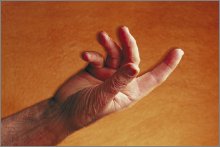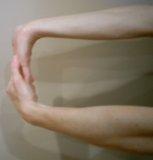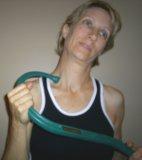Pain in the Wrist? FREE Trigger Point Self-Test and Self-Treatment Solutions
by www.SixWise.com
Take a simple 3-part test to see if your pain is caused by something that may have even fooled your doctor ... and try these simple solutions!
Background: Why is Wrist Pain so Prevalent?
Millions of Americans suffer from chronic wrist pain that can range from tingling, to throbbing, to sharp and piercing. The incidence of wrist pain (and hand pain) has been the most common complaint involving the upper extremities ever since we all started spending so much time using computers (and therefore keyboards and mice), according to the American Academy of Family Physicians.
|

Human wrists, according to some experts, were not designed for today's modern lifestyle. |
Computers, of course, are not the only things to blame for Americans' painful wrists. It may simply be that our wrists (all nine tendons, six bones, two nerves, tissue and more) are just not cut out for the rigors of daily life.
"We're taking an anatomy that has evolved over hundreds of millions of years," said Mayo Clinic hand expert Peter Amadio in an NPR article, "but not necessarily for the purposes we're putting it to at the moment. The human hand is doing lots of different things, using lots of different positions, and lifting heavy things, doing fine manipulations, a variety of different activities, and so these tissues need to adapt. And it's not unreasonable that the adaptations might fail in certain cases."
This failure, along with a number of other factors, has left many people searching for answers when it comes to their aching wrists.
Wrist Pain: Commonly Misdiagnosed?
Dr. Justin Tossing, Clinic Director of North Glen Physical Medicine, states, "Most patients with wrist pain are given misdiagnoses to fit the treatments the doctor administers, i.e., drugs and/or surgery, neither of which are appropriate or necessary in majority of cases. Simple noninvasive techniques to alleviate wrist pain treat the cause, eliminating the need for a cure. Myofascial Trigger Points [painful knots in muscles] in the wrist, arm, shoulder, and neck are the true cause of most wrist and hand pain. These [trigger points] can be treated easily even by the patient themselves."
Dr. Tossing goes on to explain that outside of obvious injuries, wrist pain can be difficult to diagnose, and are often misdiagnosed, as follows:
-
Carpal Tunnel Syndrome (CTS): "Used by many doctors as a catch-all diagnosis when symptoms are generally described as nerve pain, numbness, and/or tingling in the hands. Most diagnosed cases are NOT true CTS, but rather myofascial dysfunction, such as trigger points [muscle knots]." Other factors that can contribute or aggravate this condition include repetitive movements, being overweight, and injury to the wrist.
-
Tendonitis: "Most doctors simply recommend rest, a temporary solution at best. Treating trigger points can solve most of tendonitis cases with no drugs or surgery within 2 weeks or less." Tendonitis occurs when the tendons surrounding the wrist joint become inflamed, causing pain and swelling. Like CTS, tendonitis can be aggravated by repetitive movements. "[This] occurs because trigger points tighten the muscles and pull on the tendons, causing them to become sore and inflamed."
-
Arthritis: If you're over 20 years old and have pain in a joint, you've probably been told you have "arthritis." Arthritis of the wrist can take on several forms:
-
Osteoarthritis is degeneration of the wrist joint caused by wear and tear. This form of arthritis can be caused by trigger points [muscle knots] that go untreated for years. Eliminating trigger points [muscle knots] through gentle hands-on techniques can greatly alleviate this pain and prevent further destruction of the joint.
-
Rheumatoid arthritis (RA) is a condition that affects the entire body, wherein the immune system destroys the joints, causing pain, swelling and stiffness in the wrists. There are many proven successful alternative treatments for RA that involve nutritional and lifestyle changes, which will be addressed in future Sixwise articles.
According to Sharon Sauer, Certified Myofascial Trigger Point Therapist and wrist pain expert:
"Trigger Points are the Most Often Missed Cause of Wrist Pain!"
|

Whenever performing a repetitive movement, such as typing, sewing, or painting, take frequents breaks to give your wrists a rest. |
Myofascial Trigger Points are painful knots in muscles where blood flow has decreased and lactic acid has built up. These knots cause tightening of the muscle that increases the pulls on tendons and joints, causing damage and pain. The most amazing fact about trigger points is that they refer pain to areas distant from their own location. Severe pain in the wrist, for example, can be caused by a trigger point in the muscles of the neck or shoulder, explaining why wrist pain is so often misdiagnosed.
Treatment of Trigger Points can be performed easily yourself using simple self-care tools, or by specially trained practitioners (myofascial trigger point therapists). Here is the process:
-
Perform a simple test to identify which muscles have the trigger points.
-
Warm up the area to be treated (where the trigger points are)
-
Use a simple tool to compress the trigger points for 3-7 seconds each
-
Stretch the muscle that you just treated
-
Perform the simple test again to see if the treatment was successful
Wrist Pain: Trigger Point Tests & Treatment Step-by-Step
While there are many tests to determine which muscles have trigger points causing your wrist pain, here are three you can easily perform to determine if trigger points are causing your wrist pain.
For each test that you fail, you need to perform the corrective self-care techniques associated with that test in order to achieve lasting wrist pain relief. You will know if you treated the right areas by decreased pain and better self-retesting. If you do not achieve relief or better self-test results, you are advised to seek further evaluation from a physician or therapist trained in myofascial trigger point therapy. can help you find a practitioner in your local area.
 Test #1: Wrist and Finger Flexors Test
Test #1: Wrist and Finger Flexors Test
Bring your arm in front of your body to shoulder level with the elbow straight. Use your other hand to pull your upper palm and fingers back in towards you.
Results: If you cannot bend the wrist up to 90 degrees or if there is any pain, this indicates you may have trigger points in the muscles that flex your wrist and/or fingers causing wrist pain. Congratulations! Your wrist pain may be easy to fix.
Treatment
Warm-up: Gently massage the forearm or wrap in a moist warm towel for 5-10 minutes.
 Compression Technique #1: Here is the compression technique that will deactivate trigger points (irritable tight spots) in your hand flexors:
Compression Technique #1: Here is the compression technique that will deactivate trigger points (irritable tight spots) in your hand flexors:
-
Stand facing the wall. Rotate the hand and arm so that your palm faces the wall. Let your arm rest against your torso. Place the Jacknobber II tool just at the elbow crease. Lean your body towards the wall, compressing with mild to moderate pressure your arm into the tool. If the spot is tender and/or you feel pain radiate into the wrist, you are pushing on a trigger point! Continue to apply pressure for 3-7 seconds. Pain level should be mild to moderate. Take two or three deep slow breaths. Focus on being relaxed. Then move the ball or Jackbobber II tool down the forearm and repeat. As the ball or Jackbobber II tool gets closer to your wrist, allow your arm to rest against the hip and thigh.
Stretch Technique #1: Now that your muscles are properly warmed up and have been pressed on (compressed), they are ready to be gently stretched and encouraged to return to their normal resting length and function. Always follow the compression technique above with the following stretch:

-
Pull the palm back. Vary the stretch by deviating to the each side of the hand (ulnar and radial). To stretch the finger flexors, pull each finger back individually. Hold for 2 seconds
-
An alternative is to put your fingers together as if you were, "praying," Then use the fingers of one hand to push and stretch the flexors of the opposite hand.
 Test #2: Wrist and Finger Extensors Test
Test #2: Wrist and Finger Extensors Test
Bring your arm in front of your body to shoulder level with the elbow straight and the wrist flexed down.
Results: If you cannot bend the wrist down to 90 degrees or if there is any pain, this indicates you may have trigger points in the muscles that extend your wrist and/or fingers causing wrist pain.
Treatment
Warm-up: Gently massage the forearm or wrap in a moist warm towel for 5-10 minutes.
.JPG) Compression Technique #2: Here is the compression technique that will deactivate trigger points (irritable tight spots) in your wrist and finger extensors:
Compression Technique #2: Here is the compression technique that will deactivate trigger points (irritable tight spots) in your wrist and finger extensors:
-
Rest your arm on a flat surface such as a table with your palm facing down. Holding the Jacknobber II tool with your opposite hand, press the tool into the muscles of the forearm just at the elbow crease. As in the above example, search for a spot that is tender and/or causes pain to radiate into the wrist. Hold it for 2-3 deep slow breaths while relaxing. Move the Jacknobber II tool down the forearm and repeat.
Stretch Technique #2: Always follow the compression technique above with the following stretches:

-
Gently stretch your hand extensors by using one hand to press the other hand into downward (into flexion). Modify by stretching the hand toward each side.
-
Then make a light fist. Using the opposite hand, gently flex the wrist and vary the stretch by giving deviation to each side.
Test #3: Cervical Lateral Flexion Test
Try to press your ear to your shoulder without raising your shoulder. How close to your shoulder can you get? Do you experience any pain when doing this test?
Results: If you cannot bend your neck to the side to 3 inches from your shoulder, or if there is any pain, this indicates you may have trigger points in the scalene muscles on the side of your neck that stabilize your spine at the neck. When the scalene muscles have trigger points, they often send pain down to the wrist. Whichever wrist has pain, the scalene muscle on the same side must be treated.
Treatment:
Warm-up: Gently massage the side of the neck or wrap in a moist warm towel for 5-10 minutes.
 Compression Technique #3: Here is the compression technique that will deactivate trigger points in your scalenes:
Compression Technique #3: Here is the compression technique that will deactivate trigger points in your scalenes:
- Press the Backnobber II tool into the muscles along the same side of the neck that you are having wrist pain (see photo). Start at the base of the neck and work upwards towards the just under the ear. Apply just enough pressure to feel mild to moderate tenderness in the muscle you are compressing. When you find a trigger point, as noted by tenderness and/or radiating pain into the hand/wrist, hold the compression for 2-3 deep slow breaths while relaxing. Then move to the next spot and repeat.
Stretch Technique #3: Always follow the compression technique above with these stretches:


-
First, pull your chin in and move your head back
-
Next, place your hand over your head just above the ear. Pull your head slowly down towards your shoulder. Breath, relax and feel the muscles in the side of your neck stretch.
-
Now, vary this stretch by looking up slightly as you do it.
-
Repeat while looking slightly down.
Other Techniques
Did you pass all three tests above but still have wrist pain? If so, your wrist pain may still be caused by trigger points in yet another muscle. There are 11 other muscle groups that also refer pain to the wrist! You may need to get a myofascial trigger point evaluation by an experienced practitioner. Don't give up!
Note: If any of these self-treatments cause increased pain or problems, do not continue performing them and see a qualified physician. Increased wrist pain is a sign that trigger points are a part of your problem, but they may need to be further evaluated by a practitioner trained in myofascial trigger point therapy. can help you find some of the best myofascial trigger point therapists in your area.
Recommended Reading
How to Sit at a Desk All Day and Still be Healthy
What are the Top Injuries in a Typical Office (and How Can You Avoid Them)?
American Academy of Family Physicians
Science Daily
About.com: Ergonomics
About.com: Orthopedics